Analysis of the Support Failure Mechanism Caused by Bolt Pre-Tightening Force Loss
Abstract
1. Introduction
2. Engineering Background
2.1. General Geology
2.2. Analysis of Failure Characteristics of Roadway
3. Material and Methods
4. Experimental results
4.1. Relationship between Bolt Pre-Tightening Force and Bolt Pre-Tightening Torque
4.2. Analysis of Loss Behavior of Bolt Pre-Tightening Force
4.2.1. Characteristics of Initial Bolt Pre-Tightening Force Loss
4.2.2. Characteristics of Bolt Pre-Tightening Force Loss under Repeated Pre-Tightening
5. Discussion
5.1. Influence of Roadway Surrounding Rock Roughness on Pre-Tightening Force Loss
5.2. Influence of Tightening Times on Pre-Tightening Force Loss
5.3. Influence of Pre-Tightening Torque Level on Pre-Tightening Force Loss
6. Preventive Actions and Engineering Application
6.1. Method of Reducing Pre-Tightening Force Loss
6.2. Engineering Application and Effect of Preventive Actions
6.2.1. Monitoring Results of Roadway Displacement
6.2.2. Monitoring Results of Bolt Stress
7. Conclusions
Author Contributions
Funding
Data Availability Statement
Acknowledgments
Conflicts of Interest
References
- Kang, H.P.; Lin, J.; Fan, M.J. Investigation on support pattern of a coal mine roadway within soft rocks—A case study. Int. J. Coal Geol. 2015, 140, 31–40. [Google Scholar] [CrossRef]
- Stone, R. Design of primary ground support during roadway development using empirical databases. Int. J. Min. Sci. Technol. 2016, 26, 131–137. [Google Scholar] [CrossRef]
- Zhang, H.; Li, H.; Zhang, T.; Wang, Q.; Wang, W.; Wang, X.; Zhao, H.; Chang, T.; Guo, T. Research and engineering application of high pre-stressed resistance enhancement large deformation bolt in deep soft rock roadway. J. China Coal Soc. 2019, 44, 409–418. [Google Scholar] [CrossRef]
- Wang, T.; Tan, B.H.; Lu, G.T.; Liu, B.; Yang, D. Bolt Pretightening Force Measurement Based on Strain Distribution of Bolt Head Surface. J. Aerosp. Eng. 2020, 33, 04020034. [Google Scholar] [CrossRef]
- Wang, X.Y.; Zhang, W.D.; Wang, G.H.; Wu, B.W.; Li, J.C.; Zheng, Z. Study on high-energy strengthening anchor mechanism of tension pre-tightening bolt support system. Coal Sci. Technol. 2021, 49, 38–44. [Google Scholar] [CrossRef]
- Wang, F.T.; Shang, J.J.; Zhao, B.; Cao, Q.H.; Niu, T.C. Strengthened anchor cable support mechanism and its parameter optimization design for roadway’s dynamic pressure section. J. China Univ. Min. Technol. 2022, 51, 56–66. [Google Scholar] [CrossRef]
- Chang, J.C.; Xie, G.X. Research on response characteristics of bolt pretension on supporting effect of rock roadway in coal mine. J. Min. Saf. Eng. 2012, 29, 657–661. [Google Scholar]
- Wang, Q.; Pan, R.; Li, S.C.; Wang, H.T.; Jiang, B. The control effect of surrounding rock with different combinations of the bolt anchoring lengths and pre-tightening forces in underground engineering. Environ. Earth Sci. 2018, 77, 501. [Google Scholar] [CrossRef]
- Jing, H.W.; Wu, J.Y.; Yin, Q.; Wang, K. Deformation and failure characteristics of anchorage structure of surrounding rock in deep roadway. Int. J. Min. Sci. Technol. 2020, 30, 593–604. [Google Scholar] [CrossRef]
- Yang, H.; Han, C.; Zhang, N.; Pan, D.; Xie, Z. Research and Application of Low Density Roof Support Technology of Rapid Excavation for Coal Roadway. Geotech. Geol. Eng. 2020, 38, 389–401. [Google Scholar] [CrossRef]
- Zheng, X.G.; Zhang, N.; Hong, H.; Feng, X.W.; Liu, N.; Hua, J.B. Relation of Bolt’s Pre-tightening Force and Anchoring Force in Deep Mines. Disaster Adv. 2013, 6, 108–115. [Google Scholar]
- Wang, Q.; Wang, H.; Pan, R.; Li, S.; He, M.; Jiang, B.; Qin, Q.; Zhang, C.; Xu, Y. Mechanical Effect Analysis and Comparative Site Tests on Surrounding Rock with Different Bolt Anchoring Lengths and Pre-tightening Forces. Geotech. Geol. Eng. 2019, 37, 1195–1209. [Google Scholar] [CrossRef]
- Li, Z.; Wang, J.; Ning, J.G.; Qiu, P.Q.; Yang, S.H.; Shen, Z. Experimental research on influence of pre-tension on dynamic load impact resistance of anchorage body. J. China Univ. Min. Technol. 2021, 50, 459–468. [Google Scholar] [CrossRef]
- Wang, Z.Y.; Jiang, P.F.; Meng, X.F.; Zhang, Z.T. Numerical study of support effectiveness and mechanism of pre-stressed bolts. J. Min. Strat. Control Eng. 2022, 4, 56–66. [Google Scholar] [CrossRef]
- Wu, D.Y.; Li, N.Y.; Zhou, S. Thickness and Strength Analysis of Prestressed Anchor (Cable) Compression Arch Based on Safe Co-Mining of Deep Coal and Gas. Sustainability 2023, 15, 10716. [Google Scholar] [CrossRef]
- Lin, J.; Kang, H.P. Cause analysis of pre-tightening loss of anchor cable and settling approach. Coal Min. Technol. 2008, 13, 6–8. [Google Scholar]
- Tian, Y.; Qian, H.; Cao, Z.F.; Zhang, D.H.; Jiang, D. Identification of Pre-Tightening Torque Dependent Parameters for Empirical Modeling of Bolted Joints. Appl. Sci. 2021, 11, 9134. [Google Scholar] [CrossRef]
- Liu, J.; Guo, T.; Wei, Y.; Wang, L.B.; Zou, X.X. Investigation of the effect of pre-tightening forces on bolted connection for FRP-steel joints. Case Stud. Constr. Mater. 2023, 19, e02348. [Google Scholar] [CrossRef]
- Liu, Z.F.; Zheng, M.P.; Yan, X.; Zhao, Y.S.; Cheng, Q.; Yang, C.B. Changing behavior of friction coefficient for high strength bolts during repeated tightening. Tribol. Int. 2020, 151, 106486. [Google Scholar] [CrossRef]
- Zheng, M.; Liu, Z.; Yan, X.; Niu, N.; Zhang, T.; Li, Y. Initial losing behavior of pre-tightening force for threaded fastener during repeated tightening. Eng. Fail. Anal. 2022, 134, 106021. [Google Scholar] [CrossRef]
- Yu, Q.M.; Zhou, H.L.; Wang, L.B. Finite element analysis of relationship between tightening torque and initial load of bolted connections. Adv. Mech. Eng. 2015, 7, 1687814015588477. [Google Scholar] [CrossRef]
- Nassar, S.A.; Ganeshmurthy, S.; Ranganathan, R.M.; Barber, G.C. Effect of tightening speed on the torque-tension and wear pattern in bolted connections. J. Press. Vessel. Technol. Trans. ASME 2007, 129, 426–440. [Google Scholar] [CrossRef]
- Hu, J.; Zhang, K.; Cheng, H.; Qi, Z. Mechanism of bolt pretightening and preload relaxation in composite interference-fit joints under thermal effects. J. Compos. Mater. 2020, 54, 4929–4946. [Google Scholar] [CrossRef]
- Chen, W.; Wu, Z.; Zhu, Z.H.; Chen, W.Y.; Wang, W.D.; Zeng, Z.P. Pull out and pre-tightening force tests for plastic dowel of the railway sleeper considering the influence of installing torque and frost force. Constr. Build. Mater. 2021, 267, 120948. [Google Scholar] [CrossRef]
- Wang, C.; Du, Z.S.; Li, Z.B. Calculation and prediction of initial support pressure in bolt support. J. China Coal Soc. 2012, 37, 1982–1986. [Google Scholar] [CrossRef]
- Huang, S.; Jin, X.; Wang, Z.F.; Zhang, Z.J.; Xiao, M.Z.; Cui, C. A study of the relationship between pre-tightening force and torque in precision instrument assembly. In Civil, Architecture and Environmental Engineering, Proceedings of the International Conference on Civil, Architecture and Environmental Engineering (ICCAE), Taipei, Taiwan, 4-6 November 2016; Kao, J., Sung, W.P., Eds.; VOLS 1 AND 2; CRC: London, UK, 2017; pp. 985–990. [Google Scholar]
- Mouda, M.; Nabhani, M.; El Khlifi, M. Surface roughness effects on non-Newtonian MHD non-parallel squeeze film bearing. Ind. Lubr. Tribol. 2021, 73, 45–51. [Google Scholar] [CrossRef]
- Tan, L.; Wang, C.; Liu, Y.; Sun, W.; Zhang, W. Study on hysteresis and threaded fitting behavior of bolted joint with non-parallel bearing surface. Mech. Syst. Signal Pr. 2022, 168, 108655. [Google Scholar] [CrossRef]
- Chen, D.; Ma, Y.; Hou, B.; Liu, R.; Zhang, W. Tightening behavior of bolted joint with non-parallel bearing surface. Int. J. Mech. Sci. 2019, 153–154, 240–253. [Google Scholar] [CrossRef]
- Croccolo, D.; De Agostinis, M.; Vincenzi, N. Influence of tightening procedures and lubrication conditions on titanium screw joints for lightweight applications. Tribol. Int. 2012, 55, 68–76. [Google Scholar] [CrossRef]
- Otsu, T.; Komatsu, K.; Hashimura, S.; Imado, K. Shear properties under the starved condition of polyisobutylene lubricant for use in screw tightening-effect of operating condition on lubrication properties. Tribol. Int. 2018, 122, 133–142. [Google Scholar] [CrossRef]
- Eccles, W.; Sherrington, I.; Arnell, R.D. Frictional changes during repeated tightening of zinc plated threaded fasteners. Tribol. Int. 2010, 43, 700–707. [Google Scholar] [CrossRef]
- Kang, H.P.; Jiang, T.M.; Gao, F.Q. Effect of pretensioned stress to rock bolting. J. China Coal Soc. 2007, 7, 680–685. [Google Scholar]
- Zhou, Y.; Zhu, Y.P.; Ren, Y.Z. Anchor deformation of flexible supporting system with prestressed anchors. China Railw. Sci. 2015, 36, 58–65. [Google Scholar]
- Mei, X.; Chen, G.; Liu, H.Y. Experimental study on high strength bolt pre-tightening force of friction energy dissipation device. In Proceedings of the First International Conference on Information Sciences, Machinery, Materials and Energy (ICISMME 2015), Chongqing, China, 11–13 April 2015; Ching, X., Dvorik, V., Eds.; Volume 126, pp. 246–250. [Google Scholar]
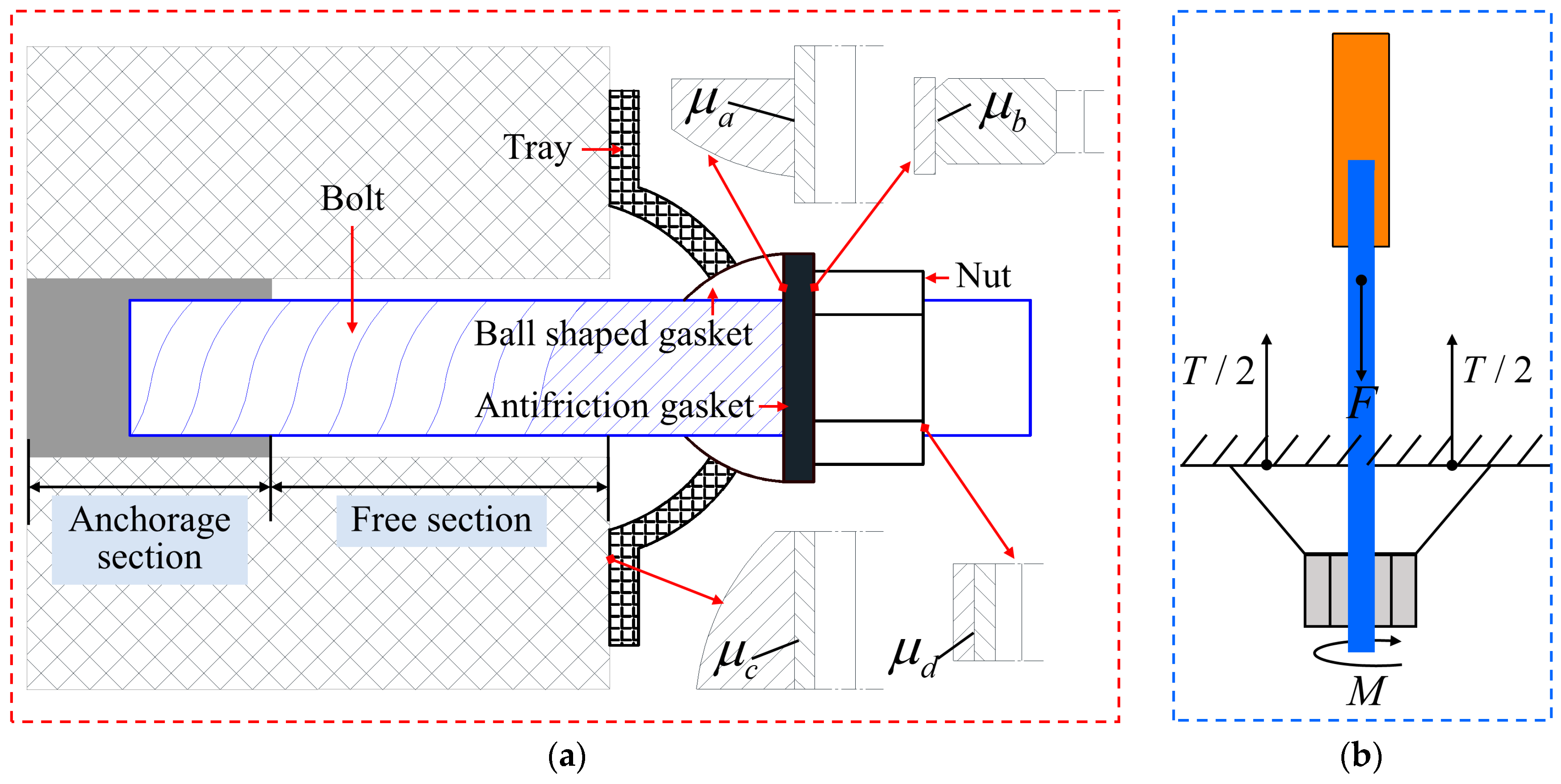


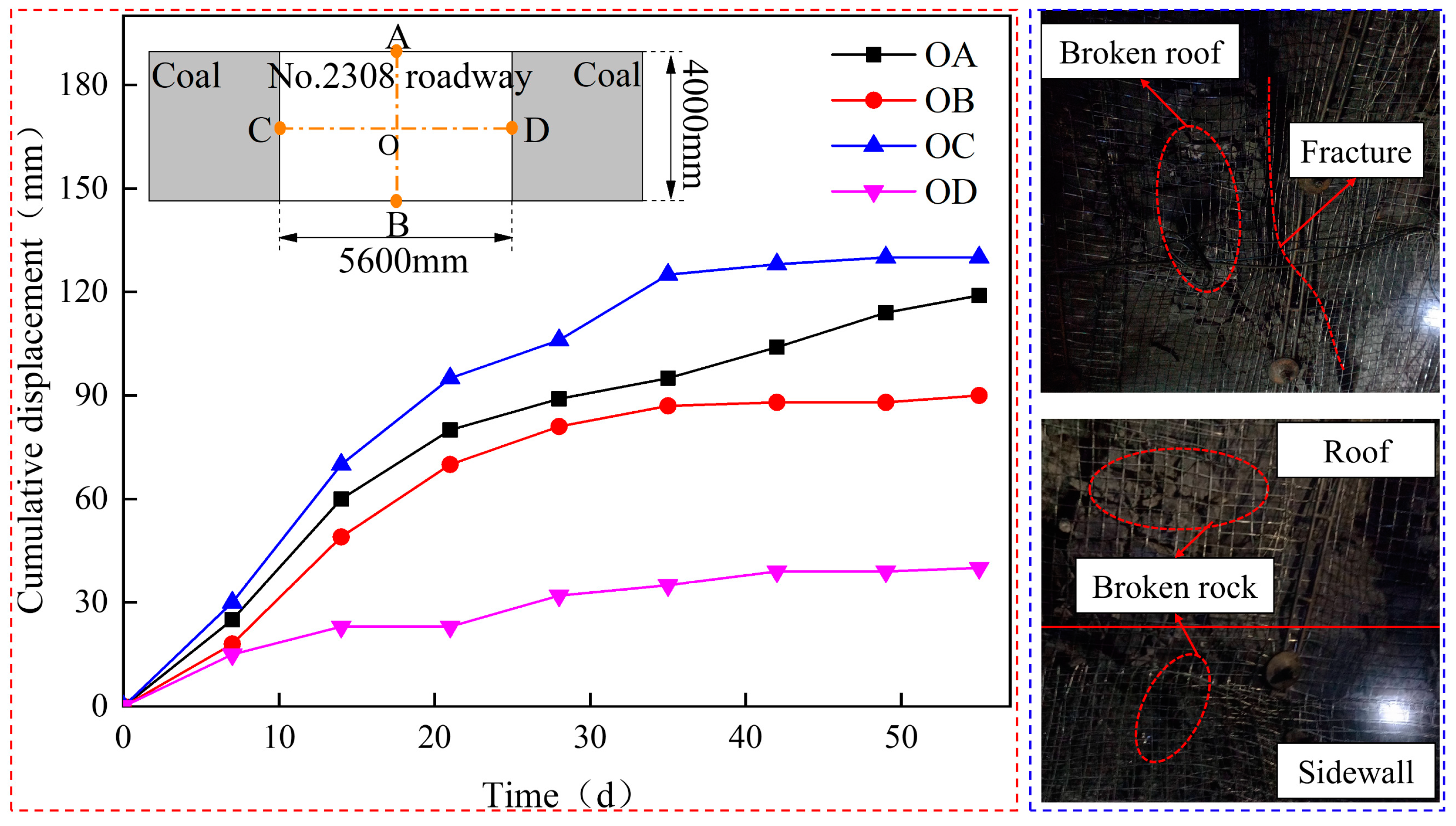


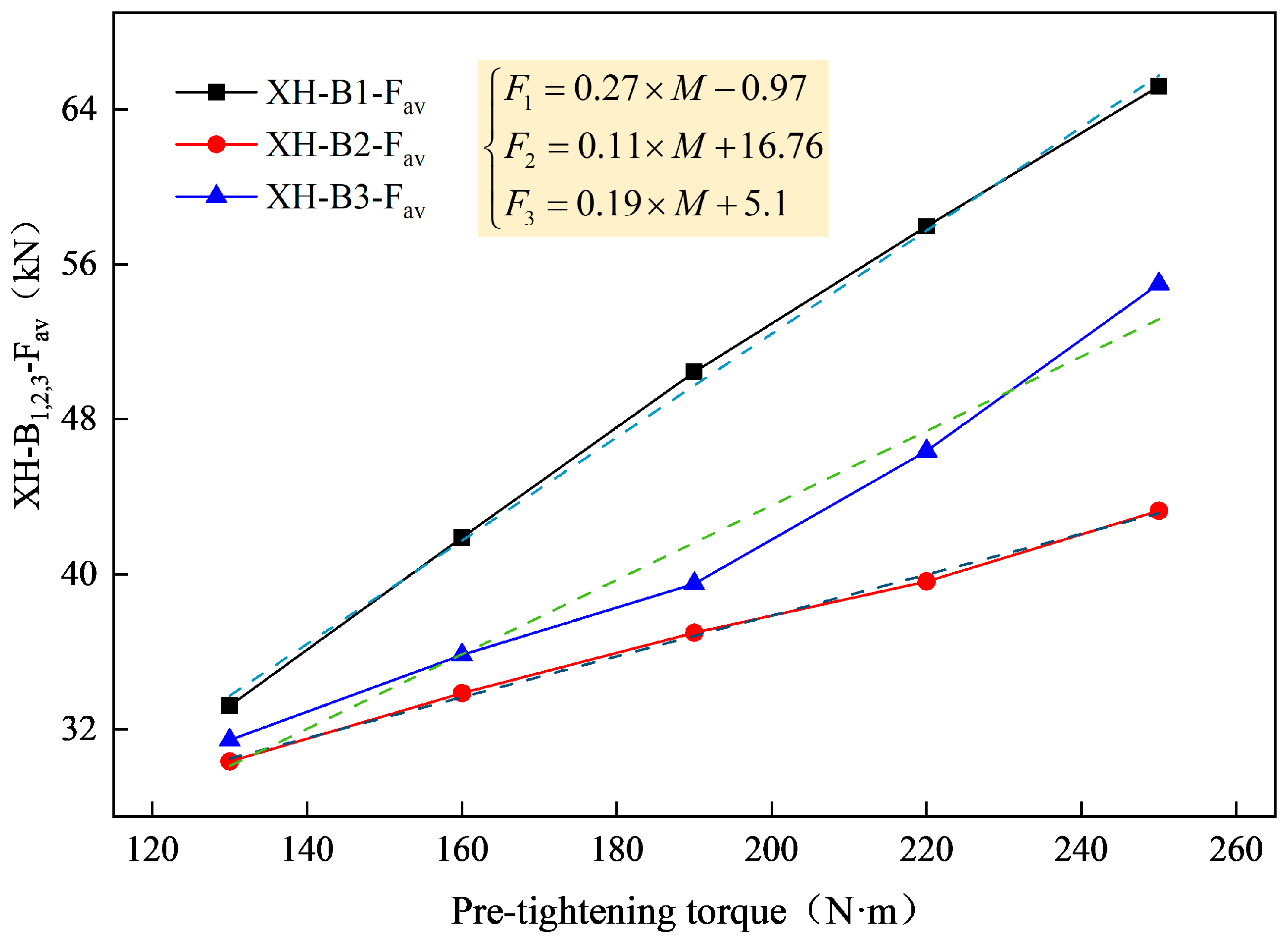
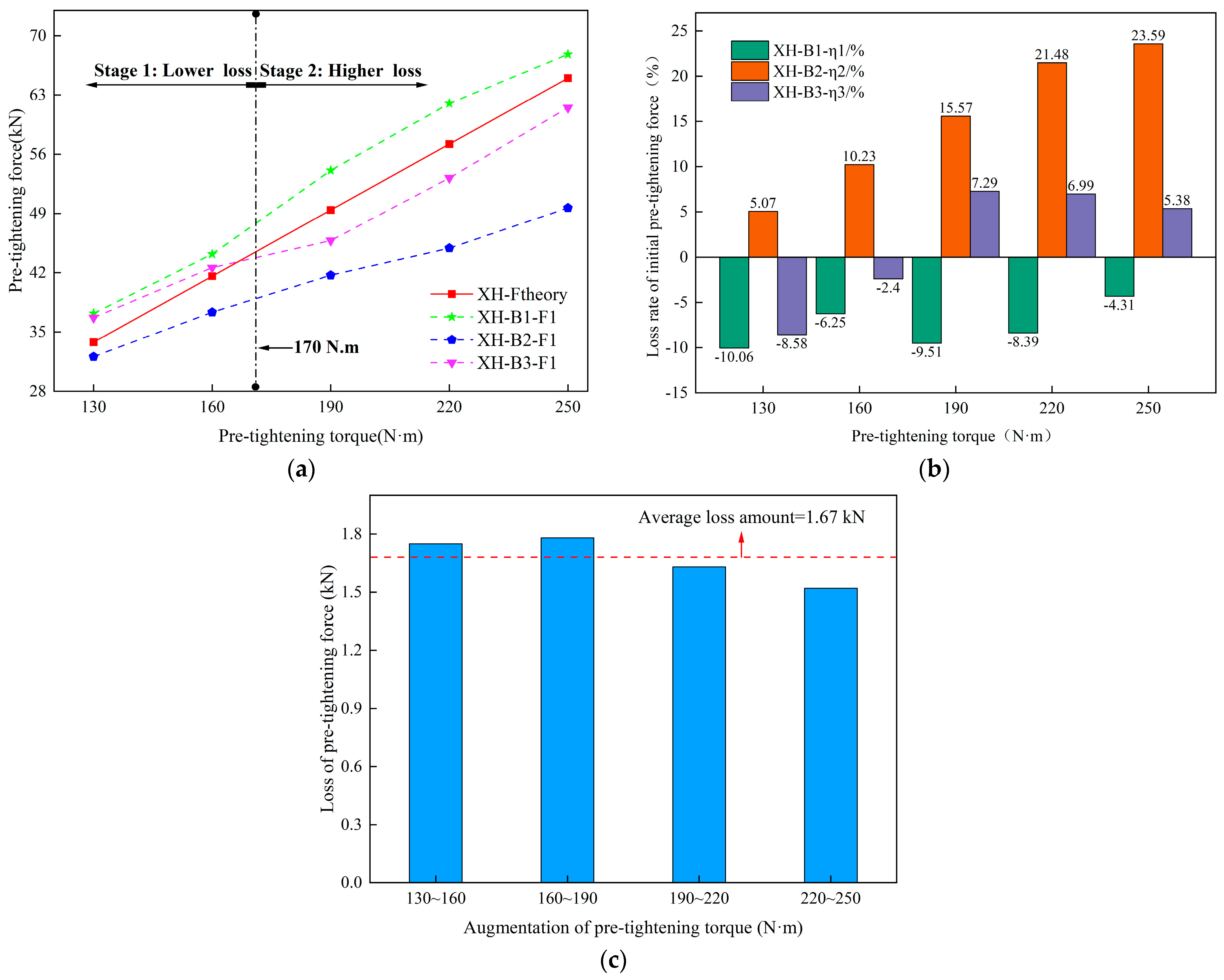
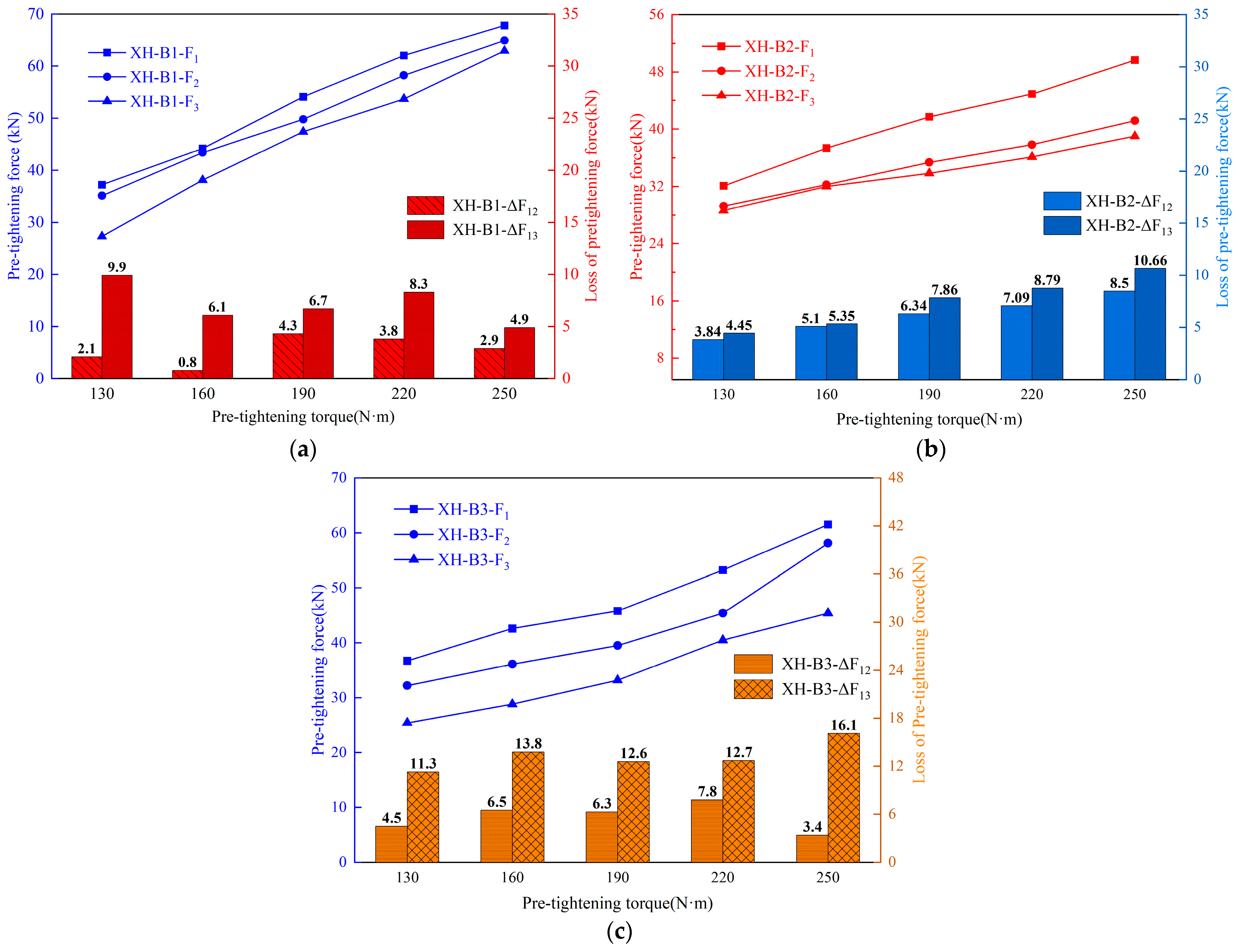
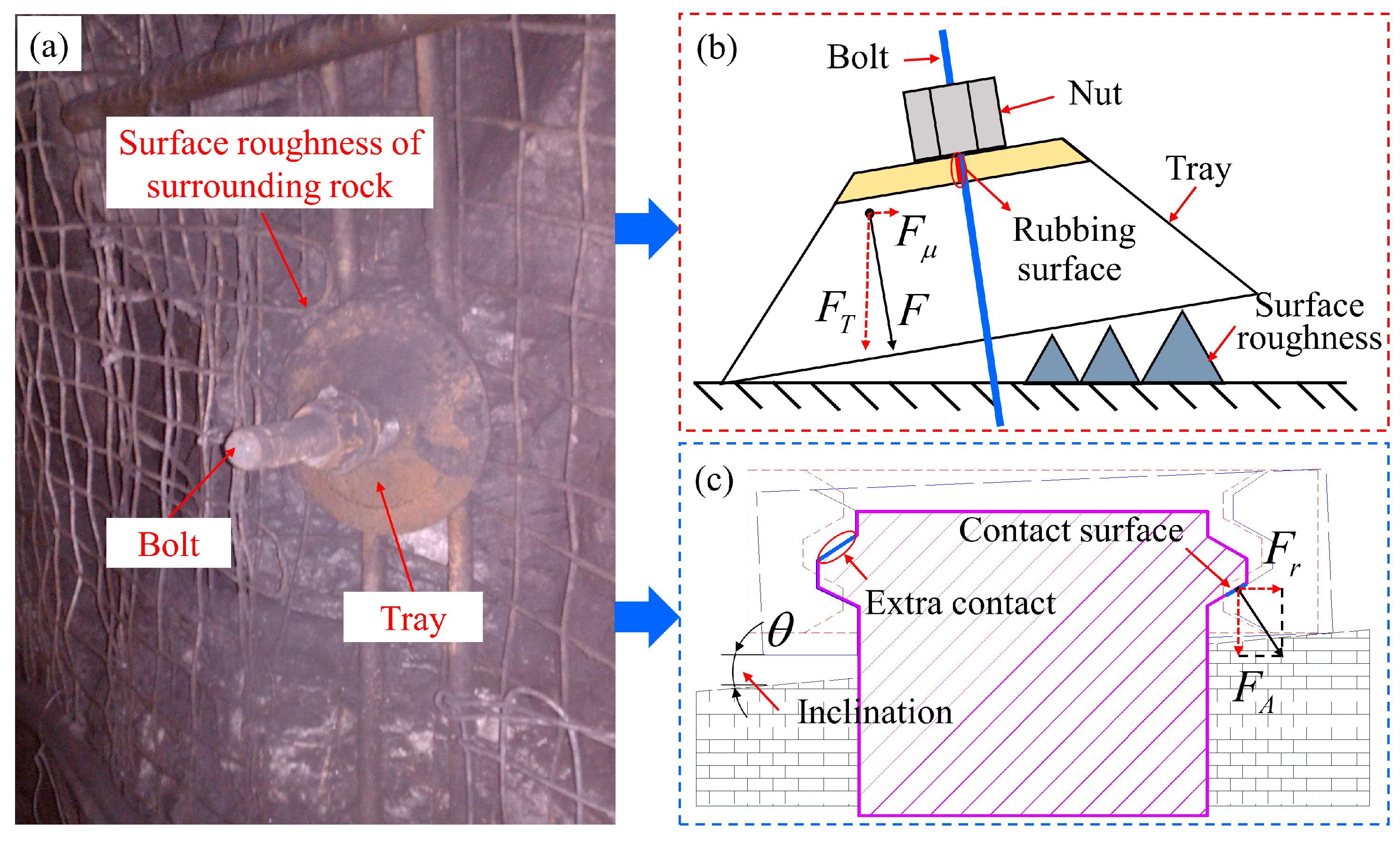
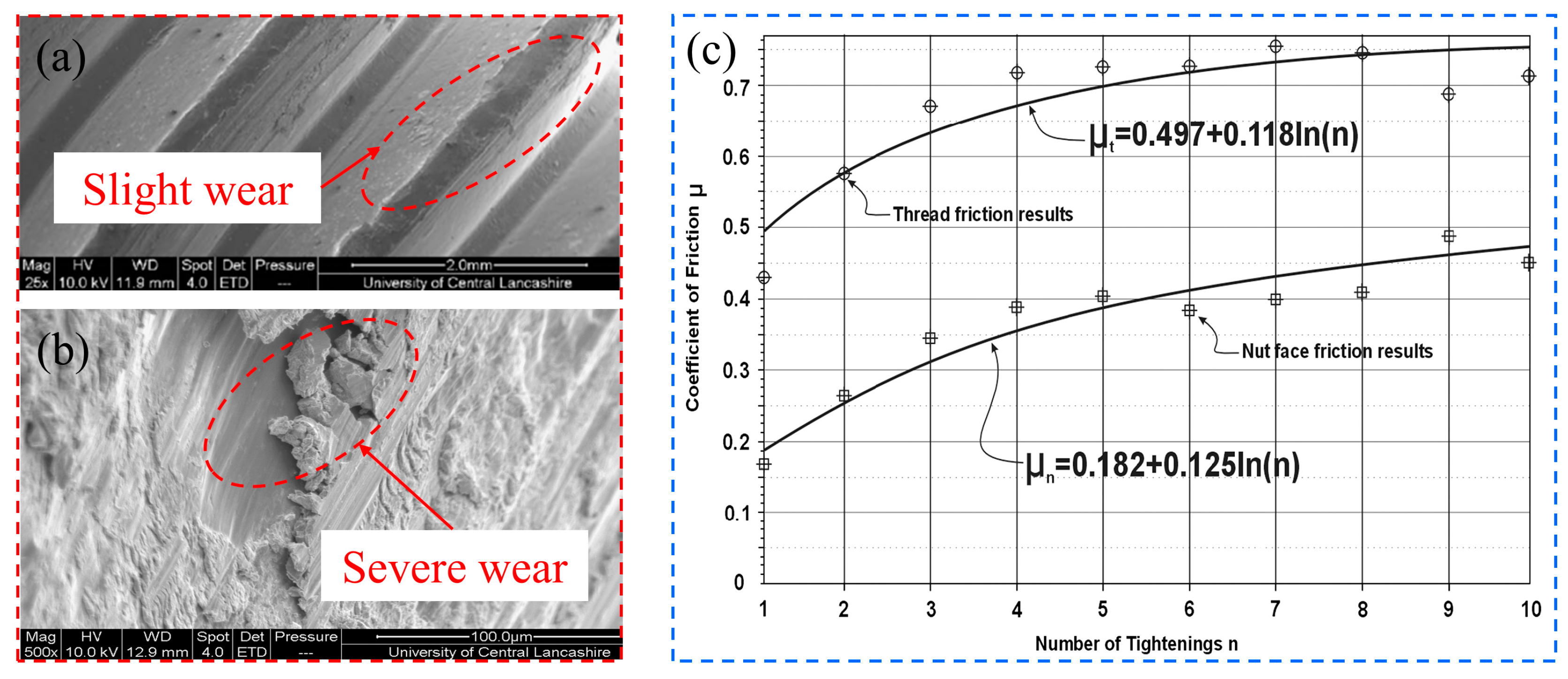
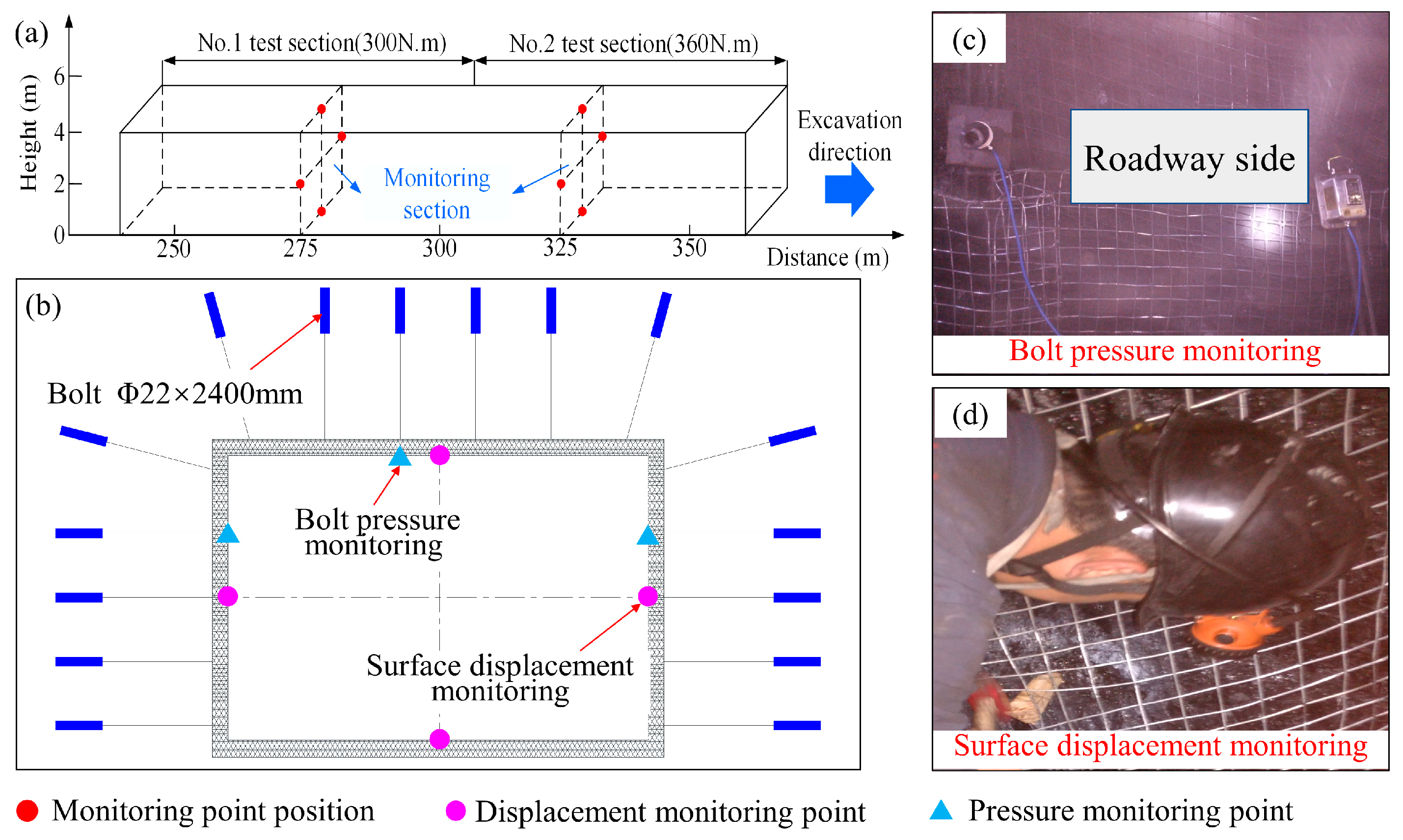
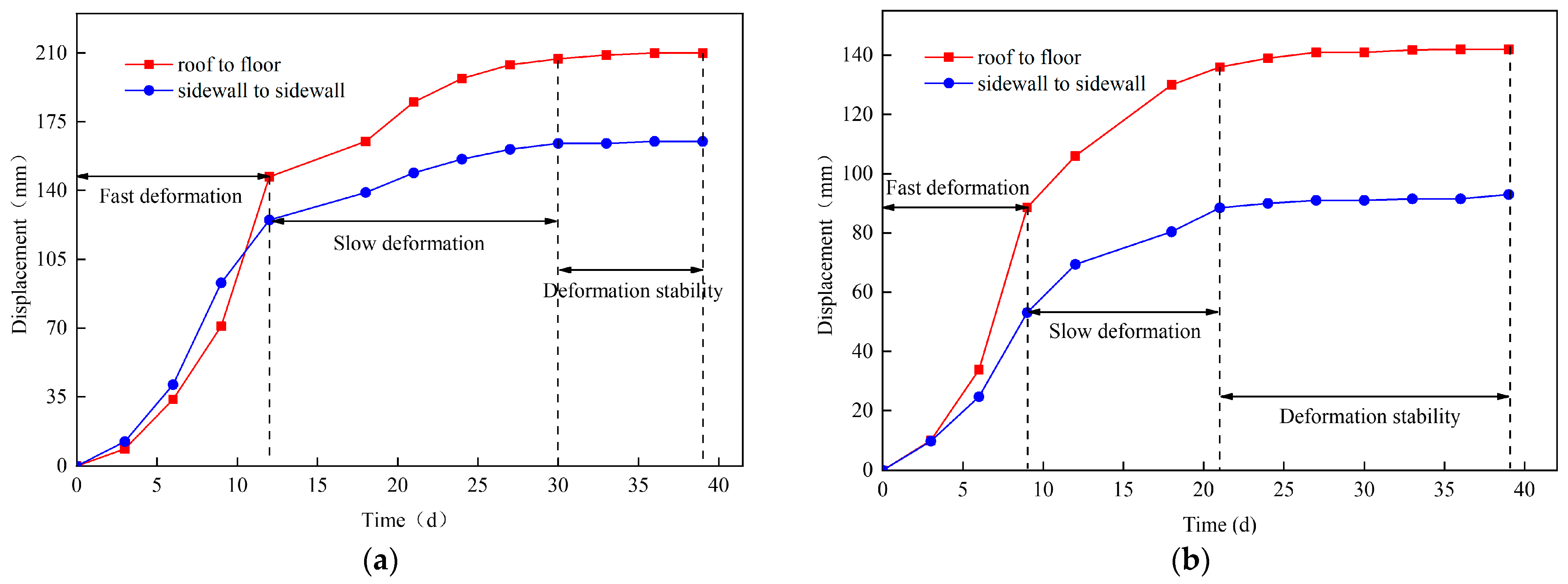

| Pre-tightening torque/N·m | 130 | 160 | 190 | 220 | 250 |
| Theoretical pre-tightening force /kN | 33.8 | 41.6 | 49.4 | 57.2 | 65 |
| Location | Initial Pre-Tightening Force/kN | Stabilized Pre-Tightening Force/kN | ||||
|---|---|---|---|---|---|---|
| No. 1 Test Section | No. 2 Test Section | Increasing Rate | No. 1 Test Section | No. 2 Test Section | Decreasing Rate | |
| Roof | 31 | 53 | 71.0% | 105 | 91 | −13.3% |
| Left side | 38 | 51 | 34.2% | 84 | 76 | −9.5% |
| Right side | 35 | 48 | 37.1% | 76 | 68 | −10.5% |
Disclaimer/Publisher’s Note: The statements, opinions and data contained in all publications are solely those of the individual author(s) and contributor(s) and not of MDPI and/or the editor(s). MDPI and/or the editor(s) disclaim responsibility for any injury to people or property resulting from any ideas, methods, instructions or products referred to in the content. |
© 2024 by the authors. Licensee MDPI, Basel, Switzerland. This article is an open access article distributed under the terms and conditions of the Creative Commons Attribution (CC BY) license (https://creativecommons.org/licenses/by/4.0/).
Share and Cite
Sun, X.; Cheng, J.; Wan, Z.; Lv, J.; Liu, K.; Gao, K. Analysis of the Support Failure Mechanism Caused by Bolt Pre-Tightening Force Loss. Processes 2024, 12, 113. https://doi.org/10.3390/pr12010113
Sun X, Cheng J, Wan Z, Lv J, Liu K, Gao K. Analysis of the Support Failure Mechanism Caused by Bolt Pre-Tightening Force Loss. Processes. 2024; 12(1):113. https://doi.org/10.3390/pr12010113
Chicago/Turabian StyleSun, Xin, Jingyi Cheng, Zhijun Wan, Jiakun Lv, Kechen Liu, and Kuidong Gao. 2024. "Analysis of the Support Failure Mechanism Caused by Bolt Pre-Tightening Force Loss" Processes 12, no. 1: 113. https://doi.org/10.3390/pr12010113
APA StyleSun, X., Cheng, J., Wan, Z., Lv, J., Liu, K., & Gao, K. (2024). Analysis of the Support Failure Mechanism Caused by Bolt Pre-Tightening Force Loss. Processes, 12(1), 113. https://doi.org/10.3390/pr12010113






